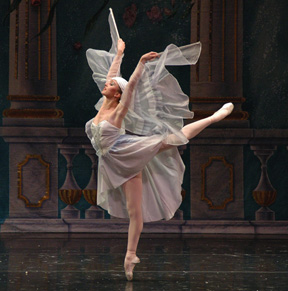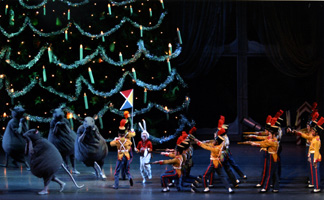
(845) 246-6944
· info@ArtTimesJournal.com
 Moscow Ballet's Ethereal Dove |
By
Francine L. Trevens
ART TIMES December
2006
There are many Christmas holiday traditions
throughout the world, which have little to do with religion. There’s Santa Claus, the giving of gifts,
carol singing, readings of the “Night Before Christmas” and viewings
of various “takes” on Scrooge.
There’s plum pudding, mince pies, eggnog and fruitcakes.
In the world of dance, there is a tradition that
dates back the to the late 19th century – the tradition
of The Nutcracker, the marvelous ballet Pyotr Ilyich Tchaikovsky was
commissioned by Marius Petipa to compose for Russia’s Kirov Ballet.
Based on Alexandre Dumas’ adaptation of E.T.A. Hoffmann’s book, “The
Nutcracker and the Mouse King,” which was published in the early 1800s,
the ballet was choreographed by Lev Ivanov and conducted at that premiere
performance on Dec. 8, 1890 by Riccardo Drigo.
Marius
Petipa, renowned dancer/choreographer who choreographed the composer’s
Swan Lake and The Sleeping Beauty Ballet, wrote the libretto for The
Nutcracker, to which Tchaikovsky composed the music. The Nutcracker
was one of the composer’s final works. He died November 6, 1893 a year
after its premiere. A suspicion was raised that the composer
might have taken poison, but the official records state he died of cholera,
which had killed his mother when he was only fourteen years old. Pyotr Ilyich suffered fits of depression
throughout his life, yet his music resounds with romanticism, lyricism
and hope.
A disciple of Petipa’s, Lev Ivanov, who preferred
the Romantic era to the Classical era Petipa himself espoused, gave
full vent to his preference in The Dance of the Snowflakes segment from
The Nutcracker. In it,
he tried to create the look and feel of an actual snowstorm. According
to reports at the time, he did it with a simplicity that beautifully
translated the music into movement.
Tchaikovsky is remembered
for many types of musical works – 10 operas, sonatas, string quartets,
cantatas, symphonies, songs and ballets, but no ballet by any composer
is performed as regularly, world wide, as The Nutcracker.
The Nutcracker ballet
was performed in various parts of its native Russia after its debut
at the Mariinsky Theatre of St. Petersburg, It took almost forty years
before it made it to Europe. Its
popularity grew rapidly, however, since the nineteen thirties, and now
it is performed in European countries as divergent as the Czech Republic,
Finland, Denmark, England and in Asia, Australia, New Zealand and throughout
the Americas, including Canada, the Dominican Republic and Venezuela.
It first appeared in the United States performed
by the Ballet Russe in 1940. The first staged in America Nutcracker
was choreographed by Willam Chistensen for the San Francisco Ballet
later in the 1940’s.
 The Nutcracker New York city Ballet ©Paul Kolnik |
Since then, it has
been adopted by almost every major city in the U. S, and is a traditional
part of the Christmas season throughout Texas, California, Virginia,
Florida and the Northeast. George
Balanchine’s choreography for the New York City Ballet is often credited
for being the version which popularized the ballet.
It is often performed
with movements transposed, and for a long time The Nutcracker Suite,
eight selections from the ballet which Tchaikovsky himself selected,
was mistaken for the entire 90-minute ballet.
The Suite premiered a year before the complete ballet was performed.
Everyone is familiar
with one part of the music or another.
It is used in movies as background music, has been adapted for
commercials, and rings forth from radio stations every Christmas season.
It is difficult to
believe, therefore, that his piano teacher, who told him not to go into
the music field as he hadn’t the talent for it, discouraged Tchaikovsky. When he began composing, critics were
scathing. Even when the
critics panned Tchaikovsky, however, he was a popular favorite, though
he himself often felt inadequate as a composer.
He had many misgivings about The Nutcracker as he was composing
it. His romantic style was against the trend
of the times. Later in
his lifetime, of course, he was much appreciated, was given many special
awards, and his 1812 Overture,
composed in the 1880’s, remains a frequently performed piece along with
his operas, ballets and other music.
It was a tradition in
our family to attend The Nutcracker, a most special part of the winter
season. My older daughter
saw it when she was three and was entranced.
When we took my 3-year-old younger daughter, she was so frightened
as the music turned foreboding and the godfather, Herr Drosselmeyer
appeared, she grew hysterical.
She and I spent most of the first act in the lobby, where, fortunately
we could still enjoy the music.
I guess that’s why they recommend it for children four and over.
The story takes place On Christmas Eve. After
playing games and receiving gifts, young Clara, leaving her bed at midnight,
comes back downstairs to the tree and her precious nutcracker doll,
which her brother had broken. Her godfather fixed it, but she is checking to be sure it is
safe and sound when she falls asleep and has an incredibly detailed
fantasy dream.
She thinks the nutcracker
doll, given her by Herr Drosselmeyer, has come to life and fought, leading
the toy soldiers, against enormous mice. The fight concludes when the Nutcracker, with Clara’s help,
slays the multi-headed mouse king.
Then Clara arrives
with the Nutcracker in the enchanted forest of the land of snow. Dancing snowflakes welcome them. They then go to the Land of Sweets, where
the SugarPlum Fairy regales them with a celebration of dance when she
learns of the defeat of the mouse king.
The dancers represent many ethnicities, such as Spanish, Arabian,
Russian, and Chinese. The
dances end with the Waltz of the Flowers, followed by a lovely Pas De
Deux between the SugarPlum Fairy and her Cavalier.
Clara awakens to find
herself near the tree with her Nutcracker cradled in her arms.
This is a variation
on the original book, in which Clara was named Maria, and many other
details were different.
Some of the greatest
ballet names have choreographed this incredible ballet.
In Rudolph Nureyev’s version, Nureyev danced both
Drosselmeyer and the Prince, but did NOT dance the role of the Nutcracker.
He changed the order of some musical numbers, and repeated the
“mice attack” towards the end. In the original book, the mouse king
was not killed, so this followed that original story somewhat.
In Baryshnikov’s version,
broadcast on TV in 1977, while the entire Tchaikovsky score is used,
the order of many dances in ACT II was changed, the Arabian dance was
cut and the Pas De Deux was between Clara and the Prince, instead of
the SugarPlum Fairy and her cavalier, among other differences.
Moscow Ballet has
been seen throughout The United States, including Saginaw, Michigan;
Grand Forks, North Dakota; San Diego, California among others. This year, it has scheduled 70 cities on its holiday
tour. Moscow Ballet’s Artistic
Director and choreographer Anatoli Emelianov stars as the Enchanted
Nutcracker Prince, with Anastasia Mikheykina and Maria Makarenko alternating
the role of Masha (Clara in the U.S).
Emelianov’s Nutcracker is praised for its unique setting of ACT
II in the “Land of Peace and Harmony.”
To convey this, he introduced a new character, an ethereal Dove
that leads Masha and the Nutcracker Prince to the land where there are
no wars or suffering. The
painted backdrop of playful lions, unicorns and peacocks provides a
vibrant setting for larger than life puppets that delight young and
old.
In San Antonio they
have David Dixon’s Nutcracker, which premiered in 1995 and is purportedly
performed to Petipa’s specifications.
The English Royal Ballet
has a new rendition to be performed at the Royal Opera House. This erstwhile company was founded by
Sir Frederick Ashton with Ninette de Valois. Ashton had a distinguished
career as dancer and choreographer.
He studied with Leonide Massine, among others. He is seen on American TV in Cinderella as one of the wicked
stepsisters. In The
Royal Ballet's current version if The Nutcracker, Lev Ivanov's choreography
is re-interpreted by Peter Wright.
English
National Ballet of London, now in its fifth year, offers the ballet
in Southampton and at the London Coliseum with Christopher Hampson’s
choreography. It
is a “fun” version with special touches that give it a more modern feel.
The
Boston Ballet production, in its 39th year, performs at Boston’s
Opera House, using 300 children from the Boston Ballet School. The current production is choreographed
by Mikko Nissinen, who hails from Finland, studied at the Kirov Ballet
School, danced with the Dutch National Ballet and the San Francisco
Ballet, among others.
The New York City
Ballet at the New York State Theatre uses 90 dancers, 63 musicians,
50 students from the school, 73 stage hands and has performed the ballet
since 1954 – dancing over 150 Nutcrackers. It’s tree, growing
from seven feet to 40 feet, its bouncing big mice, the lady with a skirt
which opens to reveal a passel of children, are all distinctive memories
from its earliest performances. For my family, this is the definitive
Nutcracker.
Undoubtedly, people around the country feel their
annual presentation is the sine quo non of this incredibly popular,
long loved and long-lived ballet.